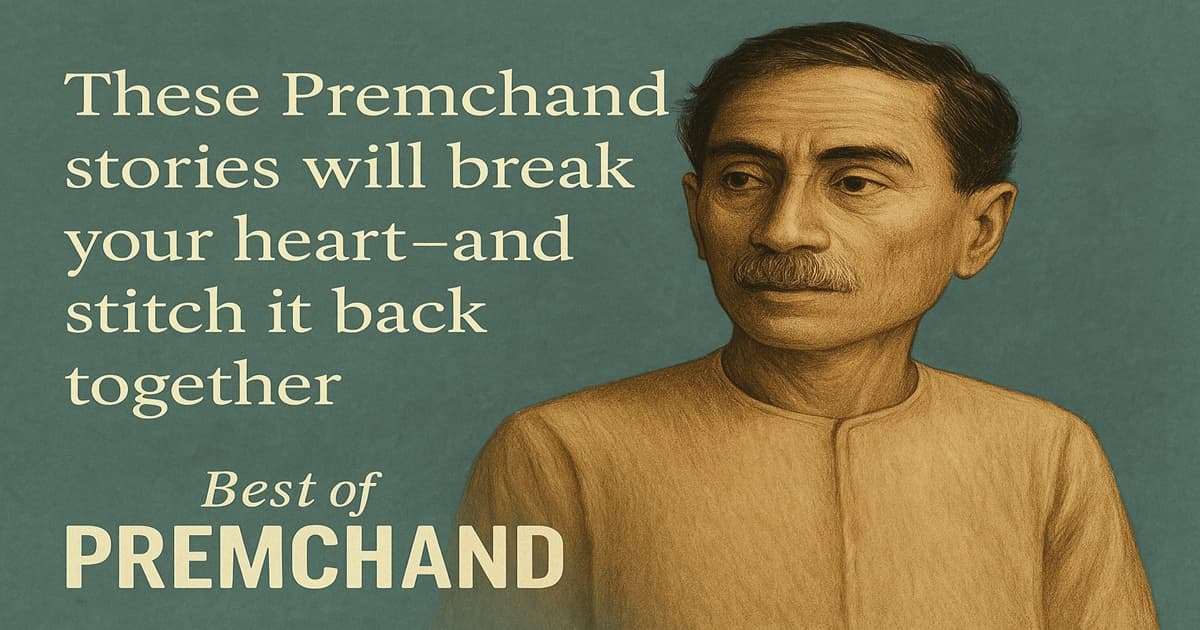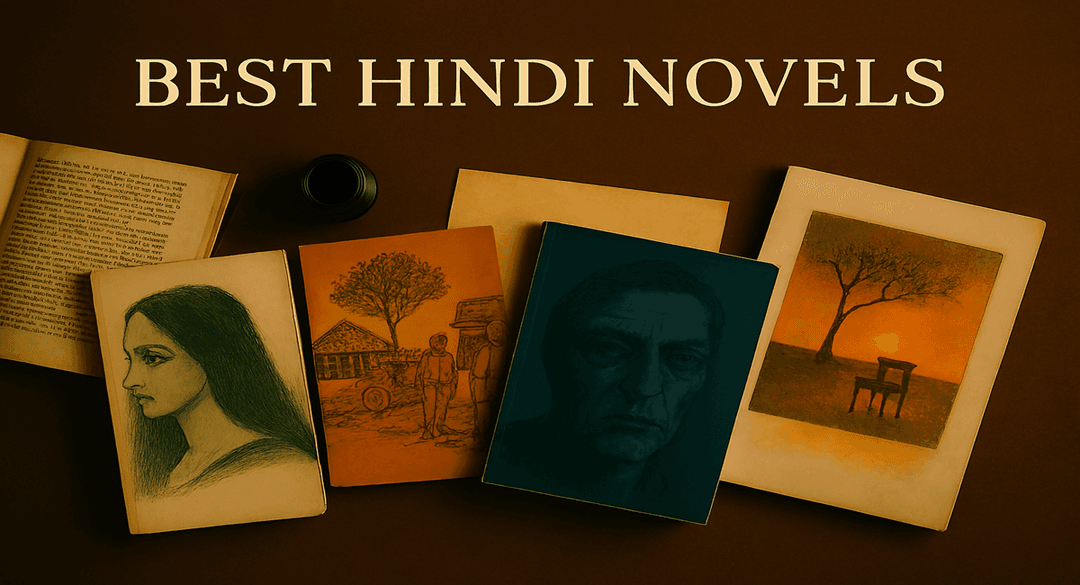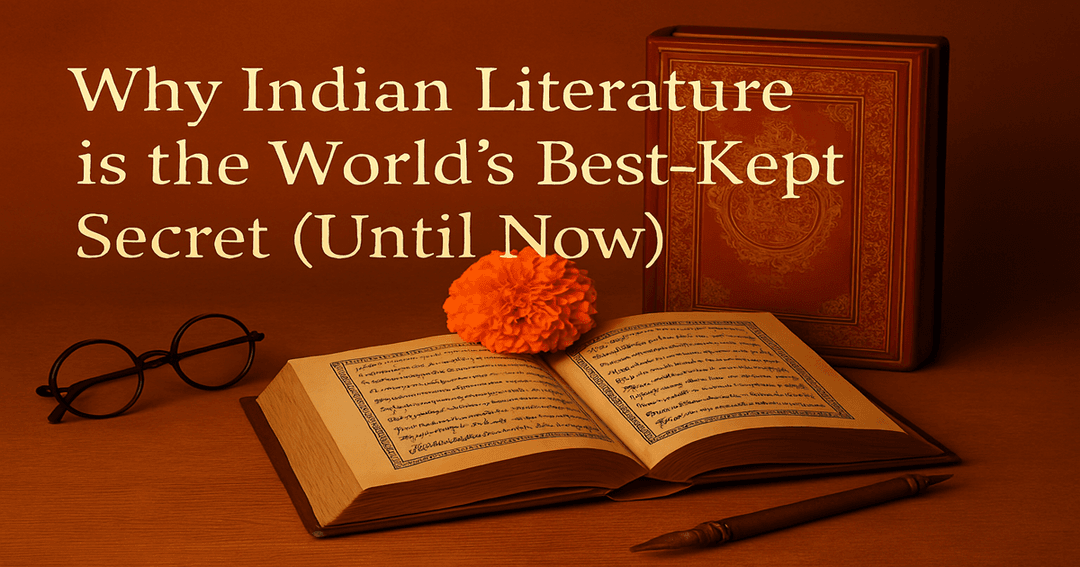Discover the timeless masterpieces of Munshi Premchand, India's most celebrated author. From Godaan to Nirmala, explore his finest novels, short stories, and their enduring impact on Indian literature.
Munshi Premchand, born Dhanpat Rai Srivastava, stands as a towering figure in Indian literature, earning the title "Upanyas Samrat" (Emperor of Novels). His profound understanding of rural India, masterful storytelling, and social consciousness have made his works essential reading for generations. This comprehensive guide explores the best of Premchand's literary contributions, examining his greatest novels, most impactful short stories, and the themes that continue to resonate with readers worldwide.
Who Was Munshi Premchand?
Premchand (1880-1936) revolutionized Hindi and Urdu literature by bringing realism to Indian fiction. Unlike his contemporaries who focused on romantic idealism, Premchand depicted the harsh realities of Indian society with unprecedented honesty. His works addressed social issues like poverty, caste discrimination, women's rights, and rural exploitation, making literature a vehicle for social reform.
Writing in both Hindi and Urdu, Premchand created characters that felt authentic and situations that reflected the struggles of ordinary Indians. His literary legacy includes over 300 short stories, numerous novels, essays, and plays that continue to influence writers and readers across the Indian subcontinent.
The Greatest Novels by Premchand
1. Godaan (The Gift of a Cow) - 1936
Widely regarded as Premchand's magnum opus, Godaan represents the pinnacle of Hindi literature. This final novel tells the story of Hori, a poor peasant whose lifelong dream is to own a cow, symbolizing prosperity and respectability in rural Indian society.
Why It's a Masterpiece:
Comprehensive portrayal of rural Indian society
Complex character development spanning multiple social classes
Powerful critique of feudalism and economic exploitation
Deep exploration of caste hierarchy and social injustice
Realistic depiction of peasant life and agricultural challenges
Key Themes:
Economic disparity between landlords and peasants
The futility of dreams in an unjust social system
Dignity of labor and human aspirations
Corruption in village administration
Women's subjugation in patriarchal society
Literary Significance: Godaan established the template for social realist fiction in Hindi literature, influencing generations of writers to address contemporary social issues through their work.
2. Nirmala - 1927
This powerful novel addresses the social evil of dowry and child marriage through the tragic story of Nirmala, a young girl married to a widower much older than herself. Premchand's nuanced treatment of complex family dynamics makes this one of his most emotionally resonant works.
Why It's Essential Reading:
Groundbreaking portrayal of women's issues in Indian society
Psychological depth in character analysis
Critique of arranged marriages and age disparities
Exploration of jealousy, misunderstanding, and family conflicts
Progressive stance on women's education and independence
Key Themes:
The dowry system and its devastating effects
Generational conflicts within families
Women's lack of agency in marriage decisions
The importance of education for women
Misunderstandings and their tragic consequences
Impact: Nirmala sparked important conversations about marriage customs and women's rights, contributing to social reform movements of the early 20th century.
3. Gaban (Embezzlement) - 1931
Gaban explores the moral decline of Ramanath, a middle-class clerk who embezzles money to satisfy his wife's materialistic desires. This novel brilliantly examines the corrupting influence of materialism on personal relationships and moral values.
Why It Resonates:
Relevant critique of materialism and consumerism
Complex moral questions without easy answers
Realistic portrayal of middle-class aspirations
Psychological study of guilt and redemption
Social commentary on changing Indian society
Key Themes:
The conflict between desires and means
Moral corruption in pursuit of social status
The price of maintaining appearances
Redemption through self-realization
Impact of Western influence on Indian values
Modern Relevance: Gaban's themes of materialism and moral compromise remain strikingly relevant in contemporary consumer society.
4. Sevasadan (House of Service) - 1918
Originally written in Urdu as "Bazaar-e-Husn," this novel was Premchand's first major work to address prostitution and women's exploitation. The story follows Suman, a woman forced into prostitution due to social circumstances, and her eventual redemption.
Why It's Groundbreaking:
Bold treatment of taboo subjects
Sympathetic portrayal of marginalized women
Critique of social hypocrisy regarding sexuality
Early feminist themes in Indian literature
Call for social reform and women's rehabilitation
Key Themes:
Social causes of prostitution
Hypocrisy of respectable society
Women's economic dependence and vulnerability
Importance of education and self-reliance
Possibility of redemption and social acceptance
Historical Significance: Sevasadan was revolutionary for its time, challenging social taboos and advocating for the rehabilitation of fallen women.
5. Rangbhoomi (The Arena) - 1925
This ambitious novel tells the story of Surdas, a blind beggar who becomes a symbol of resistance against industrial exploitation. Set against the backdrop of British colonial rule, it explores themes of nationalism, industrialization, and social justice.
Why It Stands Out:
Epic scope covering multiple social issues
Strong nationalist undertones
Memorable protagonist who embodies Indian resilience
Critique of industrial capitalism
Complex plot involving love, betrayal, and redemption
Key Themes:
Resistance against colonial exploitation
Impact of industrialization on rural communities
Individual heroism in the face of systemic oppression
The power of moral conviction over material force
Unity across caste and class lines in fighting injustice
Literary Merit: Rangbhoomi showcases Premchand's ability to weave personal stories into larger social and political narratives.
The Most Celebrated Short Stories by Premchand
1. Kafan (The Shroud) - 1936
Perhaps Premchand's most famous short story, Kafan tells the devastating tale of Ghisu and his son Madhav, two impoverished laborers who cannot afford a shroud for their dead wife/daughter-in-law. This masterpiece of social realism exposes the dehumanizing effects of extreme poverty.
Why It's Unforgettable:
Stark portrayal of poverty's impact on human relationships
Dark humor mixed with tragedy
Critique of social indifference to the poor
Powerful symbolism of the shroud
Economic determinism in human behavior
Literary Techniques:
Minimalist narrative style
Effective use of irony and contrast
Psychological realism in character portrayal
Symbolic representation of social issues
2. Poos Ki Raat (The Night of Poos)
Set during the cold winter month of Poos, this story depicts the struggle of a poor farmer named Halku who must choose between buying a blanket and paying rent. The story brilliantly captures the harsh realities of rural poverty.
Why It Resonates:
Universal theme of survival and dignity
Vivid description of rural winter hardships
Sympathetic portrayal of agricultural laborers
Contrast between human needs and social obligations
Hope and resilience in the face of adversity
Artistic Excellence:
Atmospheric description of winter night
Internal conflict portrayed through external circumstances
Simple yet profound narrative structure
3. Idgah
This beloved children's story follows young Hamid's visit to the Idgah (prayer ground) during Eid festivities. Instead of buying sweets or toys, he purchases a pair of tongs for his grandmother, showing maturity beyond his years.
Why It's Cherished:
Innocent perspective on adult responsibilities
Theme of selfless love and sacrifice
Cultural authenticity in depicting Muslim traditions
Child psychology portrayed with sensitivity
Moral lesson delivered without preaching
Universal Appeal:
Transcends religious boundaries with universal themes
Celebrates the bond between grandparent and grandchild
Shows wisdom in apparent foolishness
4. Lottery
This story critiques the false hopes that lotteries create among the poor and desperate. Through the character of a poor man who buys lottery tickets hoping to escape poverty, Premchand exposes how such schemes exploit the vulnerable.
Why It's Relevant:
Early critique of gambling and get-rich-quick schemes
Psychological study of hope and desperation
Social commentary on exploitation of the poor
Realistic portrayal of lower-middle-class aspirations
5. Bade Ghar Ki Beti (Daughter of a Big House)
This story explores the challenges faced by a girl from a wealthy family who marries into a middle-class household. It addresses themes of social status, adjustment in marriage, and the clash between different lifestyle expectations.
Why It Matters:
Examination of class differences in marriage
Women's adaptation to new social environments
Family dynamics and expectations
Social mobility and its challenges
Premchand's Revolutionary Themes and Social Impact
Progressive Social Vision
Premchand's works consistently advocated for social reform and human dignity. His major themes include:
Caste System Critique: Throughout his works, Premchand challenged the rigid caste hierarchy, showing how it perpetuated injustice and limited human potential. Stories like "Sadgati" powerfully expose caste-based exploitation.
Women's Rights and Empowerment: Long before feminism became a mainstream movement in India, Premchand championed women's education, economic independence, and right to dignity. His female characters often embody strength and moral clarity.
Economic Justice: Premchand's deep understanding of rural economics led to powerful critiques of feudalism, money-lending practices, and industrial exploitation. His works show how economic systems shape human relationships and moral choices.
Religious Harmony: Despite communal tensions of his era, Premchand promoted secular values and religious tolerance. His works feature characters from different faiths working together and showing mutual respect.
Literary Innovations
Realistic Characterization: Premchand revolutionized Hindi literature by creating three-dimensional characters with complex motivations, moving away from the idealized figures common in earlier literature.
Authentic Dialogue: His characters speak in natural, colloquial language that reflects their social background and education level, making the stories more believable and relatable.
Social Setting: Premchand grounded his stories in specific social and economic contexts, making literature a mirror of contemporary Indian society.
Psychological Depth: His works explore the internal conflicts and moral dilemmas of characters, showing how external circumstances shape inner lives.
The Enduring Legacy of Premchand's Literature
Influence on Indian Cinema
Many of Premchand's works have been adapted for cinema, including acclaimed films like "Godaan," "Shatranj Ke Khiladi," and "Sadgati." Directors like Satyajit Ray and Shyam Benegal have drawn inspiration from his realistic portrayal of Indian society.
Academic Recognition
Premchand's works are integral parts of Hindi literature curricula across India. His writing techniques, thematic concerns, and social vision are studied in universities worldwide, making him one of the most analyzed authors in Indian literature.
Contemporary Relevance
Despite being written decades ago, Premchand's works remain startlingly relevant. Issues like poverty, corruption, gender inequality, and social justice that he addressed continue to challenge Indian society today.
International Recognition
Premchand's works have been translated into numerous languages, earning him recognition as one of the finest realist writers globally. His influence extends beyond India to other developing nations facing similar social challenges.
How to Approach Reading Premchand
For New Readers
Start with Short Stories: Begin with accessible stories like "Idgah" or "Poos Ki Raat" to appreciate Premchand's style and themes before tackling longer novels.
Understand Historical Context: Learning about colonial India, feudal systems, and social reform movements enhances understanding of Premchand's social critique.
Read Multiple Works: Premchand's themes and techniques evolve across his career, so reading various works provides a complete picture of his literary development.
For Advanced Study
Compare Hindi and Urdu Versions: Where available, comparing different language versions reveals Premchand's linguistic versatility and cultural sensitivity.
Analyze Social Themes: Focus on how Premchand addresses specific social issues and their contemporary relevance.
Study Character Development: Examine how Premchand creates complex, believable characters that represent broader social types.
The Best Premchand Collections and Editions
Essential Collections
"Mansarovar": This eight-volume collection contains Premchand's complete short stories, arranged chronologically to show his artistic development.
"Godan and Other Stories": Many publishers offer collections combining the novel Godaan with selected short stories, providing comprehensive introduction to Premchand's work.
"The Complete Works of Premchand": Multi-volume sets containing novels, stories, essays, and plays for serious students of his literature.
Recommended Translations
English Translations: Works by translators like David Rubin and Alok Rai have made Premchand accessible to global audiences while maintaining literary quality.
Regional Language Translations: Premchand's works have been translated into most Indian languages, spreading his influence across linguistic boundaries.
Premchand's Place in World Literature
Comparison with Global Realist Writers
Premchand's realistic portrayal of social conditions places him alongside masters like Charles Dickens, Leo Tolstoy, and Maxim Gorky. Like these writers, he used literature as a tool for social reform while maintaining high artistic standards.
Unique Contributions
Cultural Authenticity: Unlike many Indian writers influenced by Western literature, Premchand drew primarily from Indian traditions and experiences, creating genuinely indigenous literature.
Social Commitment: His unwavering focus on social justice and human dignity distinguishes him from writers who prioritized aesthetic concerns over social relevance.
Accessibility: Premchand wrote for ordinary people, using simple language and familiar situations to communicate complex ideas about society and human nature.
Critical Analysis and Scholarly Perspectives
Literary Criticism
Scholars have praised Premchand for transforming Hindi literature from romantic escapism to social realism. His influence on subsequent generations of writers cannot be overstated, as he established templates for addressing social issues through fiction.
Feminist Readings
Modern feminist critics appreciate Premchand's progressive stance on women's issues, though some critique his occasional reinforcement of traditional gender roles. His female characters often display remarkable strength and moral clarity.
Marxist Interpretations
Marxist critics value Premchand's class consciousness and critique of economic exploitation, seeing him as a precursor to more explicitly political literature in India.
Postcolonial Analysis
Postcolonial scholars examine how Premchand navigated between traditional Indian values and colonial modernity, creating literature that was both nationalist and universally human.
Conclusion: Why Premchand Remains Essential Reading
The best of Premchand offers readers more than literary entertainment—it provides profound insights into human nature, social justice, and the ongoing struggle for dignity in an unequal world. His masterful storytelling combines artistic excellence with moral purpose, creating works that educate while they inspire.
From the epic scope of "Godaan" to the concentrated power of "Kafan," Premchand's greatest works continue to speak to contemporary readers facing similar challenges of poverty, inequality, and social change. His vision of a just society, his compassion for the marginalized, and his faith in human potential make his literature eternally relevant.
Whether you're discovering Premchand for the first time or revisiting familiar works, his literature offers rewards that deepen with each reading. In an age of global uncertainty and social upheaval, Premchand's wisdom about human resilience, moral courage, and social responsibility provides both guidance and hope.
The best of Premchand is not just great literature—it's a roadmap for creating a more just and compassionate world. His legacy reminds us that literature at its finest serves not only art but humanity itself.
Have you read any of Premchand's masterpieces? Share your favorite work and how it impacted your understanding of Indian literature and society.




